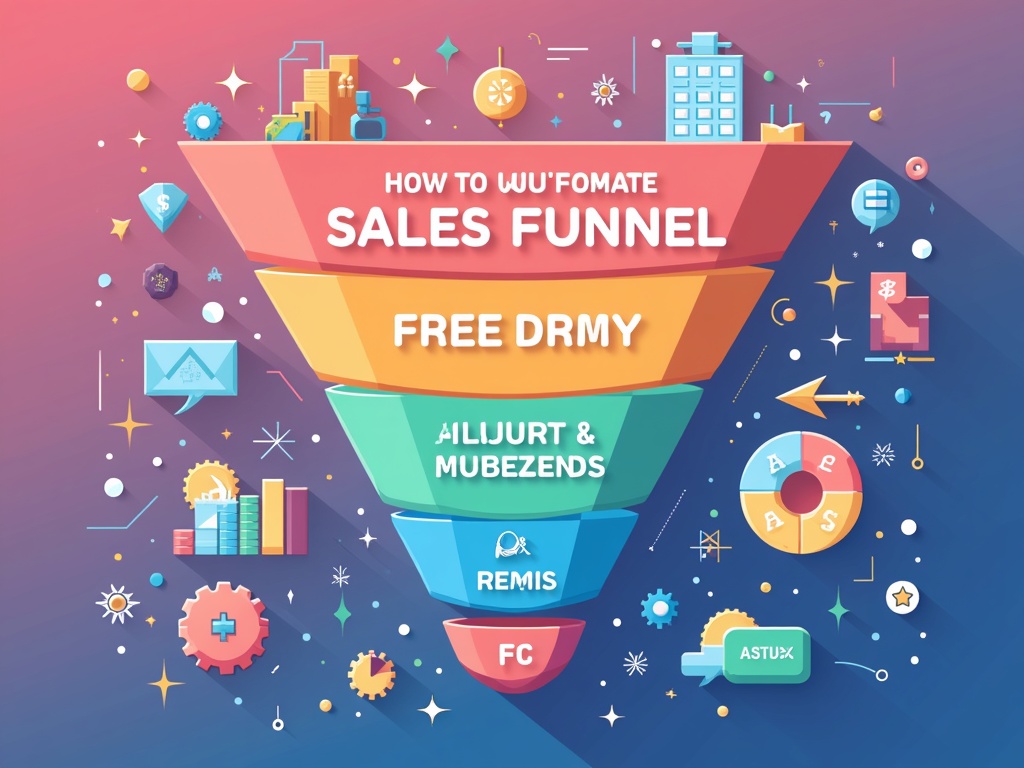How to Automate Your Sales Funnel: A Comprehensive Guide
Imagine a world where leads flow seamlessly through your sales process, nurtured and guided without constant manual intervention. No more endless email blasts, repetitive follow-ups, or missed opportunities. This is the promise of sales funnel automation: a strategic approach to streamlining your customer journey and accelerating growth. But how do you actually achieve this? Let's dive into the practical steps you can take to transform your sales funnel into a well-oiled, automated machine.
Understanding the Sales Funnel and Automation
Before we get into the how, let's clarify the what and why. A sales funnel, at its core, represents the journey a potential customer takes from initial awareness to becoming a paying client. Traditionally, this funnel is visualized in stages:
- Awareness: The potential customer becomes aware of your brand or product.
- Interest: They show interest by engaging with your content or visiting your website.
- Decision: They evaluate your solution against competitors and consider making a purchase.
- Action: They make a purchase and become a customer.
Sales funnel automation uses software and technology to automate repetitive tasks within these stages. Think automated email sequences, personalized content delivery, lead scoring, and more. The goal is to free up your sales team to focus on high-value activities like closing deals and building relationships.
Why Automate Your Sales Funnel?
The benefits of automation are numerous:
- Increased Efficiency: Automate time-consuming tasks, allowing your team to focus on strategic initiatives.
- Improved Lead Nurturing: Deliver personalized content to leads based on their behavior and interests, guiding them through the funnel.
- Enhanced Lead Scoring: Identify the most promising leads for your sales team to prioritize.
- Reduced Errors: Minimize manual data entry and reduce the risk of human error.
- Scalable Growth: Handle a larger volume of leads without adding significant overhead.
Step-by-Step Guide to Automating Your Sales Funnel
Now, let's break down the process of automating your sales funnel into actionable steps:
1. Map Out Your Current Sales Funnel
Before you can automate, you need a clear understanding of your existing sales process. This involves documenting each stage of your funnel, identifying key touchpoints, and analyzing customer behavior at each stage.
Ask yourself:
- What are the key steps a customer takes before making a purchase?
- What content do they engage with at each stage?
- How do you currently qualify leads?
- What are the common roadblocks or drop-off points in your funnel?
Use a flowchart or diagram to visually represent your funnel. This will help you identify areas where automation can have the biggest impact.
2. Choose the Right Automation Tools
Selecting the right tools is crucial for successful automation. There are numerous options available, each with its own strengths and weaknesses. Some popular choices include:
- CRM (Customer Relationship Management) Software: The central hub for managing customer data and interactions. Examples include Salesforce, HubSpot CRM, and Zoho CRM.
- Marketing Automation Platforms: Used for automating marketing tasks such as email marketing, social media posting, and lead nurturing. Examples include Marketo, Pardot, and ActiveCampaign.
- Email Marketing Software: Focuses specifically on email marketing automation. Examples include Mailchimp, ConvertKit, and AWeber.
- Landing Page Builders: Create high-converting landing pages for capturing leads. Examples include Leadpages, Unbounce, and Instapage.
- Chatbots: Automate customer service and lead generation through conversational interfaces. Examples include Drift, Intercom, and ManyChat.
Consider your specific needs and budget when choosing your tools. Many platforms offer free trials or tiered pricing plans, so you can test out different options before committing.
3. Define Your Automation Goals
What do you want to achieve with automation? Be specific and measurable. For example:
- Increase lead conversion rate by 15% in the next quarter.
- Reduce the sales cycle by 20%.
- Generate 50 high-quality leads per month.
Having clear goals will help you focus your efforts and track your progress.
4. Implement Lead Capture and Segmentation
The foundation of any automated sales funnel is capturing leads and segmenting them based on their characteristics and behavior. This allows you to deliver personalized content and guide them through the funnel more effectively.
Methods for capturing leads include:
- Landing pages: Offer valuable content in exchange for contact information.
- Website forms: Include forms on your website for visitors to sign up for newsletters or request information.
- Social media: Run lead generation campaigns on social media platforms.
- Webinars: Host webinars and collect registration information.
Once you have captured leads, segment them based on criteria such as:
- Demographics: Age, location, industry, job title.
- Behavior: Website activity, content downloads, email engagement.
- Interests: Based on the topics they engage with.
Use your CRM or marketing automation platform to create segments and tag leads accordingly.
5. Create Automated Email Sequences
Email marketing is a powerful tool for nurturing leads and guiding them through the sales funnel. Create automated email sequences for different segments, delivering personalized content based on their interests and behavior.
Examples of email sequences include:
- Welcome sequence: Introduce your brand and provide valuable resources.
- Lead nurturing sequence: Deliver educational content to build trust and credibility.
- Sales sequence: Present your product or service and encourage a purchase.
- Re-engagement sequence: Re-engage inactive leads who haven't interacted with your content in a while.
Each email in your sequence should have a clear call to action, guiding leads to the next step in the funnel.
6. Implement Lead Scoring
Lead scoring is a process of assigning points to leads based on their characteristics and behavior. This helps you identify the most promising leads for your sales team to prioritize.
Factors to consider when scoring leads include:
- Demographic information: Job title, industry, company size.
- Website activity: Pages visited, content downloaded, time spent on site.
- Email engagement: Opens, clicks, replies.
- Social media activity: Follows, shares, comments.
Set up rules in your CRM or marketing automation platform to automatically score leads based on these factors. Define a threshold score that indicates when a lead is ready to be passed on to the sales team. This ensures that your sales team focuses on the most qualified prospects.
7. Automate Social Media
Social media can play a significant role in your sales funnel, particularly in the awareness and interest stages. Use automation tools to schedule posts, engage with followers, and run targeted advertising campaigns.
Consider automating tasks such as:
- Scheduling posts: Plan and schedule your social media content in advance.
- Responding to comments and messages: Use chatbots to answer frequently asked questions and provide customer support.
- Running targeted ads: Automate the process of creating and optimizing social media ads to reach your target audience.
8. Integrate Your Tools
To maximize the effectiveness of your automation efforts, it's crucial to integrate your different tools and platforms. This allows data to flow seamlessly between systems, providing a holistic view of your leads and customers.
For example, integrate your CRM with your marketing automation platform to automatically update lead information based on their email engagement. Integrate your landing page builder with your email marketing software to automatically add new leads to your email list.
9. Test, Analyze, and Optimize
Automation is not a set it and forget it process. It's essential to continuously test, analyze, and optimize your automated workflows to ensure they are performing effectively.
Track key metrics such as:
- Lead conversion rate: The percentage of leads who become customers.
- Sales cycle length: The time it takes for a lead to become a customer.
- Customer acquisition cost: The cost of acquiring a new customer.
- Email open and click-through rates: The percentage of recipients who open and click on your emails.
Use A/B testing to experiment with different email subject lines, landing page designs, and calls to action. Analyze your data to identify areas for improvement and make adjustments to your automated workflows accordingly.
Common Mistakes to Avoid
Automating your sales funnel can be incredibly beneficial, but it's important to avoid common pitfalls:
- Over-automation: Don't automate everything. Human interaction is still important, especially in the later stages of the funnel.
- Lack of personalization: Generic content that doesn't resonate with your audience will be ignored.
- Ignoring data: Failing to track and analyze your results will prevent you from optimizing your funnel.
- Poor integration: Disjointed systems create a fragmented customer experience.
- Neglecting the customer experience: Automation should enhance, not detract from, the customer journey.
Conclusion
Automating your sales funnel is a powerful strategy for driving growth, improving efficiency, and enhancing the customer experience. By following the steps outlined in this guide, you can transform your sales process into a well-oiled machine that generates leads, nurtures relationships, and closes deals on autopilot. Remember to focus on delivering value, personalizing your communications, and continuously optimizing your workflows for maximum impact. So, take the plunge and start automating your sales funnel today – your future sales will thank you for it.

